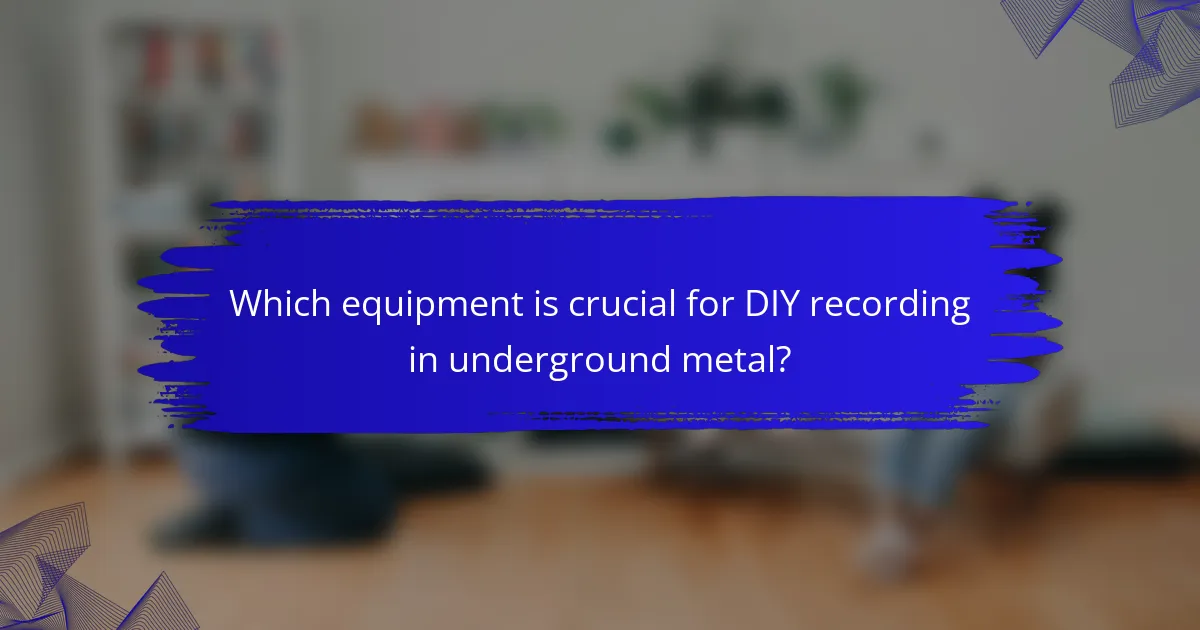DIY recording techniques for underground metal can help artists achieve professional-quality sound on a budget. Focus on essential equipment like dynamic microphones and audio interfaces, and explore effective mixing software such as Pro Tools or Audacity. Experiment with room acoustics and unique recording spaces to capture distinctive sounds. Learn tips for soundproofing and microphone placement to enhance your recordings and promote your music effectively.

What are the essential recording techniques for underground metal?
Essential recording techniques for underground metal include using high-quality microphones, experimenting with room acoustics, and employing multi-tracking. Invest in dynamic and condenser microphones to capture different sound textures. Utilize software like Pro Tools or Reaper for effective editing and mixing. Additionally, consider DIY soundproofing methods to enhance recording quality.
How do different genres within underground metal influence recording styles?
Different genres within underground metal significantly influence recording styles by shaping equipment choices and production techniques. For instance, black metal often favours lo-fi recording to enhance atmosphere, while death metal typically utilises high-quality gear to capture intricate details.
Genres like doom metal may emphasise slow tempos and heavy tones, leading to specific mic placements and reverb settings that enhance depth. Conversely, grindcore’s fast-paced nature often requires quick tracking and editing, impacting the overall sound.
DIY recording techniques reflect these influences, with artists selecting gear that aligns with their genre’s aesthetic. For example, using analog equipment can evoke a raw sound characteristic of many underground styles.
In summary, the interplay between genre and recording style is crucial for underground metal, guiding artists in their equipment choices and production methodologies.
What role does home studio setup play in achieving a professional sound?
A well-designed home studio setup is crucial for achieving a professional sound in DIY recording. It influences acoustics, equipment quality, and workflow efficiency. Proper acoustic treatment minimises unwanted reflections, while high-quality microphones and interfaces enhance sound capture. Additionally, an organised workspace streamlines the recording process, allowing for better focus and creativity. Investing in essential gear tailored to underground metal, such as dynamic microphones and versatile audio interfaces, can significantly elevate the overall production quality.

Which equipment is crucial for DIY recording in underground metal?
Essential equipment for DIY recording in underground metal includes a quality audio interface, dynamic microphones, studio monitors, and digital audio workstation software. These tools ensure high-quality sound capture and mixing. A good pair of headphones is also crucial for accurate monitoring. Consider investing in a versatile guitar amplifier and effects pedals to shape your sound.
What are the best microphones for capturing heavy guitar tones?
The best microphones for capturing heavy guitar tones include dynamic and condenser models, each offering unique benefits. Dynamic microphones, like the Shure SM57, excel in handling high sound pressure levels, making them ideal for loud amplifiers. Condenser microphones, such as the Audio-Technica AT2020, provide a wider frequency response, capturing the nuances of the guitar tone.
For close-miking techniques, the Sennheiser e906 is excellent for its flat profile and ability to capture midrange clarity. The Royer R-121 ribbon microphone is known for its smooth high-end and natural sound, making it a favourite for heavy tones. Lastly, the AKG C414 offers versatility with multiple polar patterns, accommodating various recording setups.
Choosing the right microphone depends on the desired sound and recording environment. Combining different types can enhance the tonal richness and depth in recordings.
How do audio interfaces impact sound quality in metal recordings?
Audio interfaces significantly enhance sound quality in metal recordings by providing better analog-to-digital conversion and preamp capabilities. High-quality audio interfaces reduce noise and distortion, ensuring clarity and detail in recordings. For underground metal, where raw sound is crucial, selecting an interface with low latency and high sample rates is essential. The choice of interface can directly impact the final mix, affecting everything from guitar tones to vocal presence. Investing in a reliable audio interface leads to professional-sounding recordings that capture the intensity of metal music.
Which software options are preferred by underground metal producers?
Underground metal producers often prefer software like Reaper, Pro Tools, and Cubase for DIY recording. These options offer flexibility, powerful editing tools, and compatibility with various plugins. Reaper is known for its affordability and customisation, while Pro Tools provides industry-standard features. Cubase excels in MIDI capabilities, making it ideal for complex compositions.

How can musicians achieve the desired sound with limited resources?
Musicians can achieve the desired sound with limited resources by employing effective DIY recording techniques. Focus on using affordable equipment, such as USB microphones and simple audio interfaces, which can capture quality sound. Utilise free or low-cost software for mixing and editing, like Audacity or GarageBand, to enhance recordings. Experiment with home studio setups, using basic acoustic treatment to improve sound quality. Leverage online tutorials for tips on mic placement and recording techniques tailored to underground metal, ensuring a professional sound without high costs.
What are effective budget-friendly recording techniques?
Effective budget-friendly recording techniques include using basic equipment, optimising room acoustics, and leveraging free software. Start with a USB microphone for clear sound capture. Utilise blankets or pillows to dampen noise in your recording space. Explore digital audio workstations like Audacity or GarageBand, which offer essential features at no cost. Experiment with DIY solutions, such as homemade pop filters from pantyhose and wire hangers, to enhance recording quality without spending much.
How to utilise DIY acoustic treatment for optimal sound?
To utilise DIY acoustic treatment for optimal sound, focus on strategically placing materials to absorb or diffuse sound. Start by identifying reflective surfaces like walls and ceilings. Use materials such as foam panels, carpets, and curtains to minimise echo and enhance clarity.
Consider the room’s dimensions; larger spaces may require more extensive treatment. For specific frequencies, bass traps in corners can effectively manage low-end sounds. Regularly assess your setup to ensure it meets your evolving recording needs.

What common challenges do DIY metal recording artists face?
DIY metal recording artists face challenges like budget constraints, equipment selection, and sound quality issues. Limited funds can restrict access to high-quality gear. Choosing the right microphones and recording software is crucial for capturing the desired sound. Additionally, achieving professional-level sound in untreated spaces often requires creativity and technical skill. Balancing these factors is essential for successful DIY recordings.
How to troubleshoot common recording issues in underground metal?
To troubleshoot common recording issues in underground metal, check equipment connections, settings, and acoustics. Ensure all cables are functional and properly connected. Adjust gain levels to avoid distortion and monitor audio through headphones. Test different mic placements to capture the desired sound.
What are the limitations of home recording setups for metal?
Home recording setups for metal often face limitations such as inadequate sound quality, lack of professional equipment, and insufficient acoustic treatment. These factors can hinder the overall production value.
Common constraints include:
1. **Microphone Quality**: Budget microphones may fail to capture the full tonal range of instruments.
2. **Acoustic Treatment**: Many home studios lack proper soundproofing, leading to unwanted noise and reflections.
3. **Limited Gear**: Access to high-end audio interfaces or mixers is often restricted, affecting recording clarity.
4. **Mixing Skills**: DIY recordists may lack the expertise to achieve a polished sound, resulting in a less professional mix.
5. **Digital Limitations**: Home setups may rely on software that lacks advanced features for metal production.
These limitations can impact the final product’s quality, making it essential for underground metal enthusiasts to seek ways to mitigate them.

Which unique techniques can differentiate an underground metal recording?
Unique techniques for differentiating an underground metal recording include using unconventional recording spaces, experimenting with analog equipment, and incorporating live takes for authenticity. These methods enhance the raw sound and create a distinctive atmosphere. Utilizing unique microphone placements can capture different tonal qualities, while layering instruments in unexpected ways adds depth. The choice of effects pedals can also contribute to a signature sound, making the recording stand out in a crowded genre.
How to create atmospheric layers in metal music?
To create atmospheric layers in metal music, focus on using diverse recording techniques and effects. Start with multiple guitar tracks, layering different tones and styles to build depth. Incorporate ambient sounds, such as field recordings or synthesised pads, to enrich the soundscape. Utilise reverb and delay effects to create space and dimension, enhancing the overall atmosphere. Experiment with dynamics by varying the intensity of different elements, allowing for a more immersive listening experience.
What unconventional instruments can enhance metal recordings?
Unconventional instruments that can enhance metal recordings include items like didgeridoos, kalimbas, and found objects. These instruments add unique textures and layers, enriching the overall sound. For example, using a didgeridoo can create deep, resonant tones that complement heavy guitar riffs. Kalimbas contribute melodic elements, while found objects offer percussive effects. Integrating these unconventional instruments can lead to innovative and distinctive recordings, setting underground metal apart from mainstream sounds.

What are the best practices for mixing and mastering underground metal tracks?
To achieve the best results in mixing and mastering underground metal tracks, focus on specific techniques and equipment. Use high-quality microphones to capture raw sound and invest in a reliable audio interface for clear recordings.
Prioritise dynamic range by applying compression judiciously, ensuring instruments maintain their power without losing clarity. Utilise equalisation to carve out space for each element in the mix, enhancing the overall balance.
Incorporate reverb and delay creatively to add depth, but avoid overuse that can muddy the sound. Finally, reference your mix against professional tracks to gauge quality and make necessary adjustments.
How to achieve a balanced mix for heavy genres?
To achieve a balanced mix for heavy genres, focus on clarity and dynamics. Use high-quality microphones to capture the raw energy of instruments. Layer guitar tracks with different tones to create depth. Adjust the bass frequencies to prevent muddiness, ensuring the kick drum stands out. Employ compression selectively to maintain punch while preserving the natural sound.
What common mistakes should be avoided during the mixing process?
Avoiding common mistakes during the mixing process is crucial for achieving a polished sound. Key errors include neglecting proper gain staging, which can lead to distortion, and failing to use reference tracks, resulting in an unbalanced mix. Over-processing tracks with excessive effects can muddy the overall sound. Additionally, ignoring the importance of monitoring levels can cause clipping or loss of dynamic range. Lastly, not taking breaks can lead to ear fatigue and poor decision-making.
Which mastering techniques are specific to underground metal?
Underground metal mastering techniques focus on achieving a raw, powerful sound. Key methods include dynamic range compression, equalisation, and saturation to enhance intensity. Using analog gear can add warmth, while digital plugins help maintain flexibility. Prioritise loudness without sacrificing clarity to ensure the mix retains its character.

How can artists promote their DIY recordings effectively?
Artists can promote their DIY recordings effectively by leveraging social media, engaging with local communities, and utilising streaming platforms. Establish a strong online presence on platforms like Instagram and Facebook to showcase your music and connect with fans. Collaborate with other underground artists to expand your reach and share audiences. Use platforms like Bandcamp and SoundCloud to distribute your recordings and gain visibility. Participate in local shows and festivals to build a grassroots following. Engage with fans through email newsletters and exclusive content to foster loyalty.
What platforms are best for sharing underground metal music?
Social media platforms like Bandcamp, SoundCloud, and YouTube are ideal for sharing underground metal music. These platforms allow artists to upload tracks, connect with fans, and promote their work effectively. Bandcamp offers direct sales options, while SoundCloud provides a community for feedback and collaboration. YouTube serves as a visual platform, enhancing music discovery through music videos and live performances. Each platform caters to different aspects of music sharing, making them valuable for underground metal artists.
How to engage with the underground metal community online?
Engaging with the underground metal community online involves using DIY recording techniques effectively. Start by sharing your recordings on platforms like Bandcamp and SoundCloud. Utilise social media groups dedicated to underground metal to connect with like-minded musicians. Collaborate with others by exchanging feedback on each other’s recordings, which fosters community. Attend virtual events or live streams to interact with fans and other artists, enhancing your visibility. Lastly, consider creating tutorials or behind-the-scenes content showcasing your recording process, which can attract interest and engagement.
What role does social media play in promoting DIY recordings?
Social media significantly enhances the visibility of DIY recordings in the underground metal scene. Platforms like Instagram, Facebook, and YouTube allow artists to share their work, engage with fans, and build a community.
By utilising hashtags and tagging relevant accounts, musicians can reach broader audiences. This organic promotion fosters connections with other artists, leading to collaborations that can amplify exposure.
Furthermore, social media serves as a feedback mechanism, allowing artists to gauge audience reactions and refine their techniques. Engaging content, such as behind-the-scenes footage or live sessions, can attract more followers and create a loyal fan base.
In summary, social media is a crucial tool for promoting DIY recordings, enabling underground metal artists to share their creations, connect with audiences, and grow their presence.
What expert tips can enhance the DIY recording experience for underground metal artists?
To enhance the DIY recording experience for underground metal artists, focus on optimising equipment and techniques. Use high-quality microphones to capture aggressive vocals and instrument nuances. Invest in an audio interface with low latency for seamless recording. Experiment with different mic placements to achieve desired sound textures. Utilise digital audio workstations (DAWs) that support advanced editing features and plugins tailored for metal. Prioritise acoustic treatment in your recording space to minimise unwanted noise and reflections. Lastly, collaborate with fellow musicians for fresh perspectives and creative input.